Ramit Sethi wasn’t always financially savvy. The first big check he got went in the stock market and he immediately lost half. After that, he made it his mission to learn how money really worked and founded I Will Teach You To Be Rich, which is, frankly, a little hard to describe.

It’s a New York Times’ bestseller and a blog. It’s both free and paid online courses that teach you things like how to launch an online business, earn $1k on the side, find your dream job, and negotiate a lower rent. And he’ll even help you start and grow your online business with GrowthLab.
I Will Teach You To Be Rich is also a cult (meant in the best way possible) where hardcore fans live and breath all things IWT. They organize independent meetups and spread the gospel whenever possible.
In fact, when Ramit agreed to speak at this year’s Hustle Con, no fewer than 50 of his students bought tickets within minutes of the announcement and coordinated flights and hotels as a group.
Needless to say, we were impressed by their loyalty.
Then we heard about how IWT did $5 million in sales the first week after launching a product. With a blog and only 30 employees? How did that happen?
Thankfully, Ramit has answers. Here’s his blueprint for how they did a $5 million week and what you can do to learn from their success, adapted with his permission from this blog post. I’ll let him take it from here.
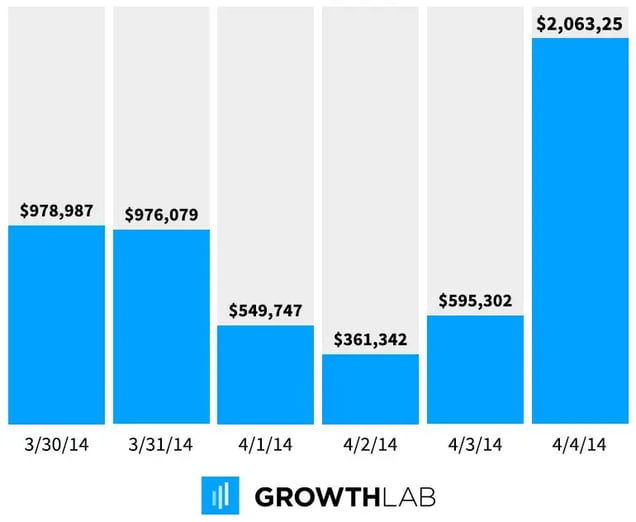
The $5 million week
In this post, I’ll show you the launch formula and strategies I used to grow a blog from $0 in revenue to a multi-million-dollar business.
Quick caveat: I had no idea that my blog — which I started from my dorm room in 2004 as a hobby — would ever turn into a “real” business.
Along the way, I learned that you can create a business using your own rules.
These are the lessons you won’t learn in any MBA program, but they can be the difference between launching a product that struggles…and one that generates millions of dollars, year after year.
This is the deeper side of business that’s not often talked about. Most of the advice I found when I started my business focused on tools and “hacks,” like A/B tests on headlines…but very little about what happens at higher levels of business. That’s why I decided to write up what I’ve learned.
Since I never expected this to become a real business, I experienced the journey with a blank canvas, in a sense. Everything was new. I didn’t know what I was “supposed” to do, so I tried it all. Over 11 years, we made some unconventional decisions in our business. Some were big mistakes. Others paid off.
Now let me show you how we got to a $5 million week.
Sales strategies to generate $5 million+ in 6 days
Selling a $2,000 product is nothing like selling a $100 product. Think how the Four Seasons is marketed vs. Holiday Inn.
I keep reading posts where nutcases (usually Silicon Valley engineers) rant about enterprise software businesses that don’t show the prices on their website. “What a waste of time,” they say. “I would never buy from this site.” They are right. They are not the customer. Instead of trying to understand the real business model, they dismiss the companies as stupid.
These companies are not dumb. They just know their customer, and it’s not the person who wants to comparison shop on price.
Here’s an example of how we sell one of our flagship courses, Zero To Launch, a course on creating your own online business:
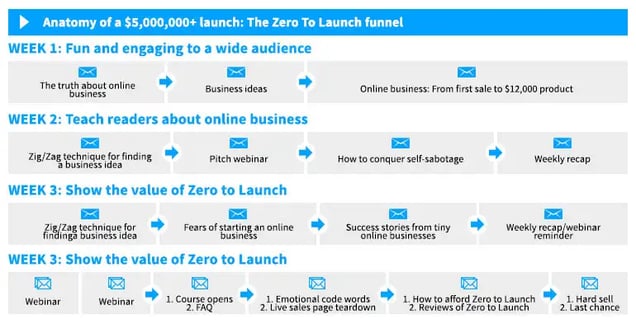
Actual $5 million email funnel from IWT
This is the sales funnel for the product, consisting of emails, blog posts, and webinars. Certain marketing elements are obvious, but others are not.
First, we aren’t reinventing the wheel in places we don’t have to. Just like Tim Ferriss wrote in The 4-Hour Workweek, “I don’t walk down the street on my hands just because everyone else walks on their feet.”
Similarly, much of the structure of this sales funnel is quite standard:
- We sent 3-5 emails per week (ignore people who say that’s emailing too much — people actually love getting emails as long as they’re good)
- We did a webinar to introduce our sales week
- We used case studies and money-back guarantee elements to provide “risk reversal”
We also used a variety of tools to power the launch:
- Email Delivery: Infusionsoft & Maropost
- A/B Testing: Visual Website Optimizer & KISSmetrics
- Webinar Hosting: Ustream
- Landing Page Platform: Leadpages
- Live Chat: ZopIM
- Customer Support: Zendesk
So far, none of this is out of the ordinary. Many entrepreneurs have used these exact strategies and tools to generate a 6-figure launch. But I didn’t want the typical 6-figure launch.
It turns out that the real decisions that drove $5 million in sales were not the tools I used nor the pricing tier we chose. In fact, many of the most important decisions contradict the “rules” we’ve all been taught.
The real decisions that drove $5 million in sales were made years before we ever launched this product.
“It’s not magic, it’s math.”
I used to look at other entrepreneurs who seemed to intuitively “know” what products to create, how much to charge, etc. Years later, I learned they actually used sophisticated models to help them make decisions. (Weird how they failed to mention that.)
Over time, I learned that it’s not magic — it’s math.
Let me show you a simple version of these models, which can help you understand where to spend your time and where to not waste it.
Take a look at what it takes to generate $1 million in one year:
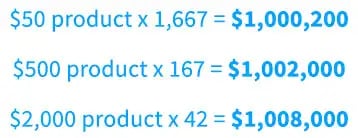
Let’s ignore what the product actually is. We can figure that out later. For now, just focus on the numbers.
Here are a few things to notice and consider:
- Isn’t it surprising how you need sell 40x more of the $50 product each month to equal the $2,000 product? (Of course, it’s much harder to sell a $2,000 product than a $50 product.)
- If someone buys from you once and likes what they get, they are far more likely to buy again. In our own analysis, a customer is 2,300% more likely to buy from us than a non-customer.
- QUESTION: Should you optimize for more customers or more revenue? Based on the numbers above, if you had to choose, what would you do? For instance, with a lower-priced product, you’ll need a lot of customers to make substantial revenue (the “McDonald’s model”). Alternatively, you could sell a higher-price product and profit from fewer customers — but those take longer to build and test (the “Rolls Royce model”).
For me, seeing these numbers raised a lot of questions. Can an entrepreneur really survive selling a $5 or even $20 product? If you’re Procter & Gamble, sure. If you’re Alex The New Entrepreneur, that’s going to be tough. (Especially since low-price customers are lower quality, ask for refunds more often, and often make your life a living hell.)
The importance of True Fans
Now let’s go one level deeper. Instead of just asking ourselves how many sales we need to make, we wanted to “stress test” our idea to see if it’s even realistic:
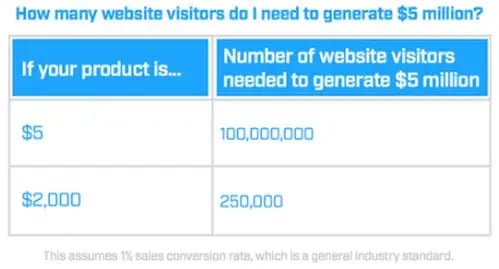
I don’t know about you, but I have no damn clue how to get 100,000,000 people to visit my website. But I knew I could find a way to get 250,000 to find me.
By the way, this isn’t all-or-nothing. If you can’t find 250,000 visitors, you can start with 50,000 or even 5,000.
Let’s say instead of 250,000 visitors (which takes a lot of time to get) you have just 1,000 email subscribers. Also, instead of creating a $2,000 product (also tough when you’re starting out) you build a $250 product.
Using the same math above — a 1% conversion rate — you could earn $2,500 per month from just those 1,000 people.
Kevin Kelly calls this the 1,000 True Fans approach, where even 1,000 true fans can fund you for life:
A creator, such as an artist, musician, photographer, craftsperson, performer, animator, designer, videomaker, or author – in other words, anyone producing works of art – needs to acquire only 1,000 True Fans to make a living.
This is pretty amazing if you want to create something with impact. It means you don’t always need venture capital fundraising. It also means that 1,000 “true” fans are worth more than 100,000 vaguely interested readers.
We actually have data to support the “1,000 True Fans” idea. Take a look at the difference between a dedicated group of “true” fans vs. a larger group of onlookers.
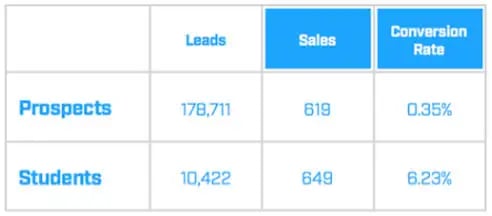
Here, we got virtually identical sales from a small group of 10,422 customers vs. a larger group of 178,111 subscribers
We got more sales from a much smaller, focused list than a huge list of 178,711 subscribers! You don’t need everyone — you just need the right people.
The world wants you to be vanilla
Have you ever noticed how the minute you start trying something new, the entire damn world tells you what you should do?
This happened when my business started growing:
- “Ramit, you really need to get on Facebook”
- “LOL $99? Maybe I’d buy it if were $0.25 and had a 30-year-guarantee” (I hate these people)
- “So you’re just one of those scammy ebook guys who writes those long sales pages?”
If you’ve ever tried to change your diet, you know what happens: Your boss, your aunt, and your garbage man all start giving you their advice.
I got this a lot. People would laugh at the name of my book. They told me my headshot sucked. And they had all kinds of tips for places I needed to advertise, including buying random people McDonald’s meals and talking to them about personal finance. Never ask the general public for marketing advice.
Here’s an unexpected lesson I learned: The world wants you to be vanilla. They want you to be the same as everyone else. But the minute you are, they abandon you.
They’ll try to get you to charge less. They’ll critique your design. But as soon as you conform…you look like everyone else. And in a world full of websites and ebooks and apps, if you look like everyone else, you’re dead.
When I started growing my business, I realized something: I could choose. This was MY business. I didn’t have to follow someone else’s formula to be successful.
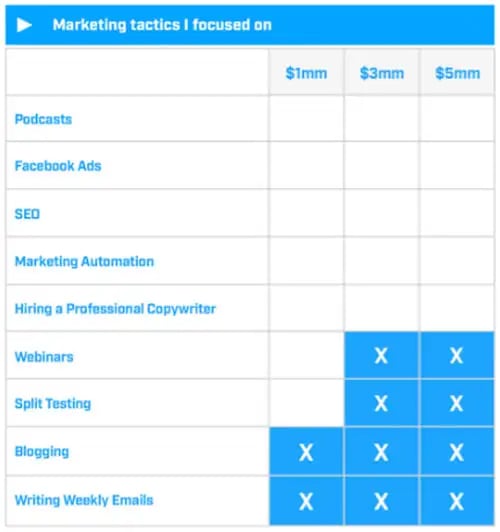
This chart should surprise you — not because of the things we did, but because of the things we chose not to do. If you listen to the advice of internet pundits, they’ll tell you how you “need to” use podcasts, SEO, SEM, marketing automation, email marketing, webinars, and on and on. Ignore them. The worst thing in the world is to be mediocre at 15 different platforms.
When I was in 4th grade, they separated the boys and girls into separate rooms and taught us a sex-ed class. I’ll never forget my teacher, Mr. Binning, giving us a serious warning:
“Guys, avoid shaving for as long as possible. Once you start, you can never stop.”
I think about his advice a lot. For instance, we used to use Aweber, a simple email service provider. As we grew, we kept hearing people tell us we “needed” to switch to a more sophisticated platform. The world wants you to be vanilla — why don’t you buy a new car? Why don’t you upgrade your software? Come on, dude.
Lessons learned
I thought that as I grew my business, I’d learn about the super-secret tools that successful entrepreneurs used once they crossed $1 million, $5 million, and beyond.
But actually, I learned two very different lessons:
My first lesson was that business isn’t just about creating money. Of course, you need to get paying customers. And when you launch, you should be fiercely focused on building an audience of people who love what you’re doing (and are delighted to pay). Ultimately, every successful entrepreneur I know looks for more meaning than another $100 of revenue. For me, it’s about impact and generosity.
My second lesson was that you can create a business your way.
There will always be people who criticize you for charging too much. Let them complain. They’re not buyers.
There will be people who tell you that you “need to” set up a Facebook page, or Twitter account, or Instagram. I didn’t have those for years. And even if you took all my social media accounts away today, it would make zero difference to my business.
And don’t always be different, especially conspicuously. I once had a friend tell me he wanted to charge $62, an unusual price, for his product. “Why?” I asked. “I just want to try something new.” My friend was being an idiot. There’s no need to reinvent the wheel: Most things in business are remarkably similar. You need a website, an email list, a sales page, and a product. Get those basic things right, and you will grow. You don’t need to reinvent the wheel on everything.
The most successful entrepreneurs — the top 1% of the top 1% — learn when to break the rules. It’s like when you learn how to dress well and you start experimenting with patterns and textures because you want to. One day, someone’s going to say, “Dude, that doesn’t even match,” and you’ll say, “So?”
It’s the same with your business. Know the best practices, execute them, but as Marshall Goldsmith says, “what got you here won’t get you there.” Your greatest successes won’t come from imitating best practices. Your competitors are almost certainly following a me-too playbook.
We were fortunate to generate $5 million in 6 days. Sure, the tools helped. Yes, the headlines mattered. But ironically, when we stopped chasing revenue and instead shifted to impact and students for life, that’s when we grew faster than ever before.
Takeaways
- Be selective about who you serve. Over time, we’ve learned to be very selective about who we allow to join us. Notice we use the word “allow” — not to be arrogant, but because we spend millions of dollars developing and testing our material, we consider it a privilege to allow someone to join.
- Find your rabid fans. Nobody builds a massive audience overnight. I wish I could go back in time and shake myself to stop comparing myself to people who’d been in business for years and years. Trust your models, put in the work, and your business will grow.
- Embrace the “student for life” philosophy. For 8 years, we’ve sent 3-5 emails per week, plus blog posts, plus videos — all free. My goal is to create free material that’s better than anyone else’s paid stuff. And when a reader uses my free material to negotiate a $28,000 raise, they instantly become a student for life.
- YOU set the strategy, not the A/B test. There are two kinds of posts that gets tons of likes on Instagram: food pics and inspirational quotes. I love nachos as much as anyone, but I’ll be damned if my Instagram is going to turn into a food-review account. The pursuit of a cheap click at the expense of all other standards is the beginning of the end for a business. Every time we’ve insisted on quality, it’s paid off. And every time we’ve tried to take a shortcut, we’ve paid dearly.
- Find time for big thinking. The first thing I learned was to be intentional. I wasn’t going “find” time unless I made it. So I started by clearing one hour per week for big-picture thinking. Eventually, I blocked off an entire day. At first, it feels weird to block off this time without any clear-cut purpose. Do it anyway. I found several million-dollar breakthroughs on my strategy days and they’ve become a catalyst for my business.
- Don’t be vanilla. When I started growing business, I realized something: I could choose. This was MY business. I didn’t have to follow someone else’s formula to be successful. Don’t be afraid to do things your own way.

